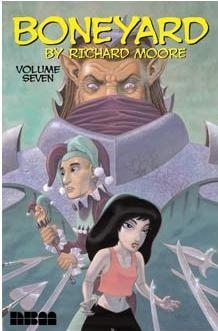Comics /
Comic Reviews /
More Comics
Boneyard Vol. 7
By Zak Edwards
August 21, 2010 - 15:31
Boneyard, Richard Moore’s comedic take on the tropes of the Horror genre, has come to its conclusion with this seventh volume and, while the ride has been enjoyable, the finale only supports the whole notion of the journey as more important than the destination. Moore’s concluding volume is filled with the usual trademark deadpan humour, witticisms, and action, if only lacking in the general high quality which has also become synonymous with the series, feeling rushed, in terms of story, production, and the actual act of reading this volume. As always, Boneyard is hardly appropriate for the younger audiences, despite the more cartoon style of art, which would lend itself somewhat deceptively to a children’s book.
Boneyard is no stranger to production mess ups when it comes to transferring these books from the singles to the trade paperbacks. For example, volume four was missing the final issue entirely, only to be reprinted with the next volume with a note of apology. This book seems to suffer smaller but fairly noticeable errors and strange anomalies which argue for a fairly sloppy and rushed production of the trade paperback, despite the gap between the release of the last issue and this having been over a year. A couple of pages early on in the issue have been printed out of order at a crucial point in the story which relies on the pacing of whole pages. The mistake is extremely distracting if only taking a couple of minutes to figure out. A “next issue” message has been left in on a single issue, despite the volume presenting the collection as a single story, lacking the usual covers to break up individual stories. Boneyard volumes have always been presented without breaks and these messages have been generally removed without any of the usual black blocks occurring in other trade collections of other series. Finally, the summary of the series presented at the beginning of the collection suggests a romantic conflict between Nessie and Abbey which simply never happens. It’s like the montages before television shows depicting past events, except they pick moments completely irrelevant to the upcoming episode and instead choose scenes and clips which are either made up, decontextualized, or simply not useful. Of course, these minor production errors can, for the most part, be overlooked, but unfortunately add up with the general air of quick production which plagues this entire volume.
And it is not to say this volume is terrible and should be ignored. There are some genuinely funny and touching moments throughout which make the book very enjoyable and worth reading, it is simply not the strongest in the series and could arguably be Boneyard’s weakest moment. The story has some pacing issues Moore encountered earlier, relying on plenty of action in a fairly big and complex story which pushes some major plot points into relative obscurity without proper attention. The second issue of the four (and it should be noted this volume has the most obvious issue breaks of the entire series, not reading as fluidly as the last) is almost entirely devoted to a series of wordless fight sequences. While Moore’s art is quite fun and great to look at, especially in the action sequences, I find the strength of Boneyard lies in the humour and great characters, none of which is expressed in a fight sequence taking up a quarter of the book and seeming to serve little, if any, purpose. In a similar vein, what starts out as a pretty awesome joke, the characters being reinterpreted in a myriad of various dimensions, runs out of steam fairly quickly yet continues to go on for far, far too long. The joke has some golden moments, including the group as all superheroes, or as pirates, but twelve repetitions of the same joke, often with the sequence taking up entire pages each, seems to be an ill-used space.
Fortunately, the book has much of what Boneyard has been known for, especially in terms of humour and great characters. Abbey and Paris’ ongoing almost romance is resolved in this concluding volume, but not without Moore’s refusal to make either fall into the trappings of typical cliches. Neither character is too doting, shy, or overly reliant on each other, in fact, both are fairly flirty and fun with each other the whole time. For once, a prospective couple has spent much of their courting phase not convincing the audience they are terrible for each other, but actually good for each other, and Abbey’s sidequest of visiting other-dimension versions of herself has a wonderful moment which really points out the ridiculousness of Abbey and Paris’ long courtship. The supporting cast takes a bit of a back seat here except for a few choice moments. Unfortunately, they get the most screen time without any speech balloons or character interaction, just standing or fighting, so the best these characters had to offer was in the volume before. There are great moments to be had here, and for the reasonable price of ten dollars, the collection should really be complete, if only to encourage Richard Moore on his later exploits. Overall, Boneyard has been a great ride, one I highly recommend, if only for the journey and not the end.
Grade: This volume: B-
Series: B+
Last Updated: January 17, 2025 - 08:20
